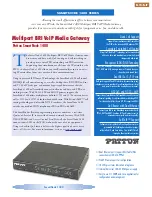
P-660HW-Tx v3 Series Support Notes
77
All contents copyright © 2008 ZyXEL Communications Corporation.
IGMP to report their multicast group membership to any immediate-neighbor
multicast routers so the multicast routers can decide if a multicast packet
needs to be forwarded. At start up, the P-660HW-Tx v3 queries all directly
connected networks to gather group membership.
After that, the P-660HW-Tx v3 updates the information by periodic queries.
The P-660HW-Tx v3 implementation of IGMP is also compatible with version 1.
The multicast setting can be turned on or off on Ethernet and remote nodes.
P-660HW-Tx v3 supports IGMP v1 ,v2 and IGMP v3 without source filtering.
IP Multicast Setup
(1) Enable IGMP in P-660HW-Tx v3's LAN in Web Configurator, Advanced
Setup,
Network -> LAN -> IP -> Advanced Setup.
(2) Enable IGMP in P-660HW-Tx v3's remote node in Web Configurator,
Advanced Setup,
Network -> WAN ->Internet Connection -> Advanced
Setup.
Key Settings:
Multicast
IGMP-v1 for IGMP version 1, IGMP-v2 for IGMP version 2. IGMP-v3 for
IGMP version 3
13. Using Zero-Configuration
Zero-Configuration and VC auto-hunting
Zero-Configure feature can help customer to reduce the burden of setting
efforts. Whenever system ADSL links up system will send out some probing
patterns, system will analyze the packets returned from ISP, and decide which
services the ISP may provide. Because ADSL is based on a ATM network, so
system have to pre-configured a VPI/VCI hunting pool before Auto-Configure
function begins to work.
The Zero-Configuration feature can hunt the encapsulation and VPI/VCI value,
and system will automatically configure itself if the hunting result is
successfully. This feature has two constraints:
1. It supports the ISP provides one kind of service (PPPoE/PPPoA, etc.)
only, otherwise the hunting will get confusing and failed.
















































